Q1. Epithelial cells of the intestine involved in food absorption have on
their surface:
Solution
The epithelium present in the lining of the intestine is columnar
epithelium. Its cells are tall, slender and bear microvilli. Microvilli are brush-like
structures which provide a larger surface area for the absorption of
nutrients from the intestine.
Q2. The
hindbrain of frog comprises
Solution
The hindbrain of frog comprises the cerebellum and
medulla oblongata.
Q3. Which one of the following is present in the integument of frog but
not in that of mammals?
Solution
In frogs, the skin is made of epidermis and dermis. The dermis
consists of mucous glands. The ducts of these glands open on the skin
surface.
In mammals, dermis, sweat glands and stratum germinativum are present
in mammals.
Q4. Histamine-secreting
cells are found in
Solution
Histamine
is secreted by mast cells which are modified basophils
of blood which occur in the loose connective tissue.
Q5. Describe the typical skeletal muscle. State any one part of the body
where skeletal muscles are found.
Solution
Typical skeletal muscle fibres are striated, bundle together and are parallel.
The several bundles are further enclosed in a tough sheath of
connective tissue.
Skeletal muscles are found in the hands (e.g. biceps).
Q6. Which of
the following is absent in frog?
Solution
Ribs are
absent in frog.
Q7. Name the respiratory organ in earthworm.
Solution
A moist skin surface is the respiratory organ of the earthworm.
Q8. The female genital pore of Pheretima
posthuma is located on which segment?
Solution
The female genital pore of Pheretima
posthuma is located on the 14th segment.
Ovarian funnels present beneath the ovaries which continue into the
oviduct and join open outside as the female genital pore.
Q9. Name the fluid connective tissue.
Solution
Blood
Q10. State the function of nephridia.
Solution
Nephridia regulate the volume and composition of the body fluids in
earthworm.
Q11. How many Malpighian tubules are present in cockroach?
Solution
100-150 Malpighian tubules are present in cockroach.
Q12. In earthworm,
Solution
In earthworm, the pharyngeal and septal nephridia are enteronephric, while the integumentary nephridia are exonephric.
Q13. Where are the spermathecal apertures located on the body of the earthworm?
Solution
Spermathecal apertures are located on the ventrolateral sides of the intersegmental grooves of 5th to 9th segments.
Q14. In which one of the following organisms, is its excretory organs correctly stated?
Solution
In earthworms, three pairs of pharyngeal nephridia are present in the 3rd, 4th and 5th segments.
Integumentary nephridia are present in the linings of the body wall from the 3rd segment to the last segment.
Septal nephridia are present on the intersegmental septa of segment 15 to the last. These nephridia open into the small intestine.
Q15. In which segment in earthworm is the clitellum present?
Solution
Clitellum is a dark band of the glandular tissue which is present in 14-16th
segments.
Q16. Uric acid is the chief nitrogenous component of the excretory product
of
Solution
Uricotelic animals excrete nitrogenous waste in the form of uric acid.
The excreta is in the form of a thick pellet to minimise water loss.
Reptiles, birds, insects and land snails are uricotelic animals. Cockroach is
an insect and hence exhibits uricotelism.
Q17. One special feature in earthworm, Pheretima, is that
Solution
The typhlosole is the median fold of the dorsal wall of the intestine between segments 26 and 35. It increases the area of absorption.
Q18. Ovaries
in frog are attached to the
Solution
The
ovaries are attached to the dorsal wall of the abdomen and kidneys by a thin
membrane known as mesovarium.
Q19. Represent diagrammatically:
(a) Unicellular glandular epithelium
(b) Cartilage tissue
Solution
(a) Unicellular glandular epithelium:
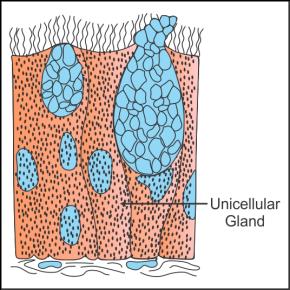 (b) Cartilage tissue:
(b) Cartilage tissue:
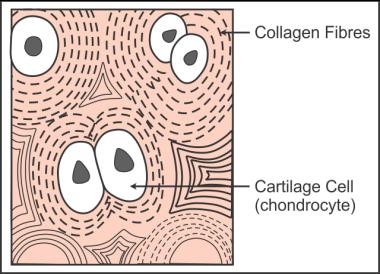
 (b) Cartilage tissue:
(b) Cartilage tissue:

Q20. Earthworms have no skeleton, but during burrowing, the anterior end becomes turgid and acts as a hydraulic skeleton. This is due to
Solution
Coelomic fluid serves as a hydrostatic skeleton and helps the muscles of the body wall in locomotion. When the circular muscles contract, the coelomic fluid provides stiffness to the body and the longitudinal muscles relax. When the earthworm holds the ground firmly, the circular muscles relax and the longitudinal muscles contract. Here, the coelomic fluid makes the region stiff which is behind the anterior region so that muscles can push the body forward.
Q21. Simple
epithelium is a tissue in which the cells are
Solution
An epithelium is a
sheet or tube of firmly adherent cells with minimum material and space
between them.
Q22. Name one gland which shows the presence of multicellular glandular
epithelium with cluster of cells.
Solution
Salivary glands
Q23. Name the membrane which joins the dorsal tergites and the ventral
sternites in cockroaches.
Solution
The arthrodial membrane which is thin, flexible and articular connects
the dorsal tergites and the ventral sternites in cockroaches.
Q24. Which one of the following has an open circulatory system?
Solution
Periplaneta (cockroach) shows the presence of the open circulatory system. Its body cavity and viscera are bathed by blood.
The heart of a cockroach is a long, tube-like structure. It lies along the mid-dorsal line of the thorax and abdomen. It is a 13-chambered organ, and the opening of each chamber into other chambers is guarded by valves.
Q25. The salivary gland in earthworm is found in
Solution
Salivary glands are bulb-like structures present in the pharyngeal
walls. The ducts of the salivary glands are present in the pharyngeal
epithelium. The glands secrete the salivary mucus in the pharynx.
Q26. Draw a labelled diagram of the open circulatory system of cockroach.
Solution

Q27. Antennae of cockroach function as
Solution
Antennae are thread-like structures which extend forward from a socket present on the head dorsally. Each antenna is made of small segments called podomeres. They are mobile and act as tactile, olfactory and thermal receptors.
Q28. The heart of cockroach is
Solution
The heart of a cockroach is a long tube-like structure. It lies along
the mid-dorsal line of the thorax and abdomen. It is a 13-chambered organ,
and the opening of each chamber into other chambers is guarded by valves.
Q29. State the significance of elastin in connective tissues.
Solution
Elastin provides strength, flexibility and elasticity to the
connective tissue.
Q30. Name the cavities in bone tissues in which osteocytes are placed.
Solution
Lacunae
Q31. In earthworm, the characteristic internal medial fold of the dorsal
wall of the intestine (called typhlosole) is present in
Solution
Typhlosole is the median fold of the dorsal wall of the intestine
between segments 26 and 35. It increases the area of absorption.
Q32. Which of the following animals is unisexual?
Solution
Cockroaches are unisexual, i.e. the sexes are separate. They are also
called dioecious.
Leech, sponges and earthworm are hermaphrodites.
Q33. Draw a well-labelled diagram representing the excretory system of earthworm.
Solution
Excretory system of earthworm:


Q34. Which structure is absent in male cockroach?
Solution
Spermathecae are present in female cockroaches. A pair of spermathecae is present in the 6th segment which opens into the genital chamber. Sperms are received and stored in the spermatheca.
Q35. Define vermicomposting.
Solution
The process of increasing the fertility of soil by earthworms is
called vermicomposting.
Q36. Mention any four sites in the human body where cartilage is found.
Solution
Cartilage is found in the human body at the following four sites - Outer
ear joints, tip of the nose, between adjacent vertebrae and between adjacent
bones in the hands and legs.
Q37. Explain nocturnal vision in cockroaches.
Solution
Each compound eye of cockroach is made of 2000 ommatidia.
With ommatidia, a cockroach can receive several images of an object.
Cockroach vision is sensitive but provides less resolution. Such vision is called mosaic vision.
This kind of vision is common during the night, and hence, it is also called nocturnal vision.
Q38. Which of
the following is not exclusively supplied with involuntary muscles?
Solution
Smooth muscles are
involuntary muscles and are found in the posterior part of the oesophagus,
stomach, urinogenital tract, blood vessels, iris of
eye and dermis of skin.
Q39. Write the functions of bones.
Solution
Functions of bones:
They serve as the main tissue in providing a support
framework to the body.
They support and protect the softer tissues and
organs in the body.
The limb bones bear the weight of the body.
The limb bones interact with the skeletal
muscles attached to them to bring about movements in the body.
The bone marrow serves as the site of
production of blood cells.
(Write any four)
Q40. Select the correct statement from the ones given below with respect to Periplaneta americana.
Solution
Males bear a pair of short thread-like anal styles. Anal styles are absent in female cockroaches.
The nervous system is located on the ventral side. It consists of segmentally arranged ganglia joined by a pair of longitudinal connectives.
There are 100-105 thin Malpighian tubules present at the junctions of the midgut and hindgut.
The gizzard also helps in the grinding of food.
Q41. What is cloaca?
Solution
Cloaca is a small median chamber which is used to pass the faecal
matter, urine and sperms to the exterior.
Q42. Name the organ which secretes digestive juices in cockroach.
Solution
Gastric caecae (hepatic caecae) secrete digestive juices in cockroach.
Q43. Draw well-labelled diagrams of the following:
(a) Columnar epithelium bearing cilia
(b) Dense irregular connective tissue
Solution
(a) Columnar epithelium-bearing cilia:
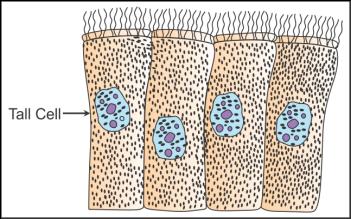 (b) Dense irregular connective tissue:
(b) Dense irregular connective tissue:
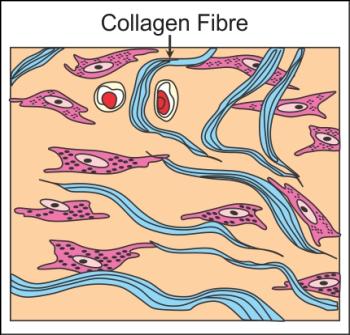
 (b) Dense irregular connective tissue:
(b) Dense irregular connective tissue:

Q44. How many ova are laid by a mature female frog at a time?
Solution
2500 to 3000 ova are laid by the female frog at a time.
Q45. What is the composition of haemolymph?
Solution
The haemolymph is composed of plasma and haemocytes.
Q46. Name the structure which is found between 26 and 35 segments in the
intestine of earthworm.
Solution
Typhlosole
Q47. The colour of the body in earthworm is brown due to the presence of
Solution
Porphyrin is a dark red pigment which is sensitive to light. It
imparts red colour to the earthworm and protects it from solar UV radiations.
Q48. State the difference between dense regular connective tissue and dense irregular connective tissue on the basis of arrangement of fibres.
Solution
Dense Regular Connective Tissue
Dense Irregular Connective Tissue
Collagen fibres are present in rows between many parallel bundles of fibres.
Fibroblasts and collagen fibres are oriented differently.
Q49. State the function of the simple epithelium.
Solution
The function of the simple epithelium is to line the body cavities,
ducts and tubes.
Q50. Write the scientific name for cockroach.
Solution
The scientific name for cockroach is Periplaneta americana.
Q51. Compared to those of humans, the erythrocytes in frog are
Solution
Erythrocytes of frogs are nucleated and carry haemoglobin. Even birds have nucleated erythrocytes. Mammals, except camels, have enucleated erythrocytes.
Q52. What is present at the junction of the midgut and hindgut? State its
function.
Solution
At the junction of the midgut and hindgut, a ring of 100-150 yellow
coloured Malpighian tubules are present. They absorb nitrogenous waste
products from the haemolymph and convert them into the excretory product,
i.e. uric acid.
Q53. Name one epithelial tissue in which the nuclei are located at the base
of cells.
Solution
Columnar epithelium
Q54. Write the name of the sclerites which cover the body of cockroach
dorsally.
Solution
Sternites
Q55. What is mesorchium?
Solution
Mesorchium is the double fold of peritoneum through which a pair of
testes is adhered to the upper part of the kidneys in frogs.
Q56. If a live earthworm is pricked with a needle on its outer surface without damaging its gut, then the fluid which comes out is
Solution
The schizocoel of earthworm, i.e. the cavity between the body wall and the alimentary canal, is filled with coelomic fluid. It is a milky white alkaline fluid which helps in protection and locomotion.
Q57. Differentiate between loose connective tissue and dense connective tissue.
Solution
Loose Connective Tissue
Dense Connective Tissue
1. Cells and fibres are arranged loosely in a semi-fluid ground substance.
1. Fibres and fibroblasts are compactly arranged.
2. Areolar tissue provides the support framework for epithelium.
2. Tendons attach skeletal muscles to bones.
3. Adipose tissue is specialised to store fats.
3. Ligaments help to attach one bone to another.
Q58. Which of the following is absent from the coelomic fluid of earthworm?
Solution
The coelomic fluid in earthworm is water plasma which contains proteins, salts and corpuscles (viz. phagocytes, leucocytes, mucocytes and eleocytes).
Q59. Pheretima and its close relatives derive nourishment from
Solution
Earthworm derives its nourishment from decaying fallen leaves and soil organic matter. The gizzard grinds the decaying matter.
Q60. The
element found in the red pigment of vertebrate blood is
Solution
Haemoglobin is a
conjugated protein composed of a protein called globin and an
Fe2+ porphyrin complex called haeme. The mineral present in the
red pigment is iron.
Q61. What are the three parts of the thorax of a cockroach?
Solution
The three parts of the thorax of a cockroach are prothorax, mesothorax
and metathorax.
Q62. State four types of animal tissues.
Solution
Four types of animal tissues are
Epidermal tissue
Connective tissue
Muscular tissue
Neural tissue
Q63. Which one of the following structures in Pheretima is correctly matched with its function?
Solution
The clitellum is a glandular tissue present in segments 14 to 16. It secretes a substance during cocoon formation which encircles the worm. It is a dark band of tissue which secretes mucus and albumin.
Gizzard - grinding of food particles
Setae - help in locomotion of the earthworm
Typhlosole - increases the absorption area in the intestine
Q64. The four sketches (A, B, C and D) given below represent four different types of animal tissues. Which one of these is correctly identified in the options given along with its correct location and function?
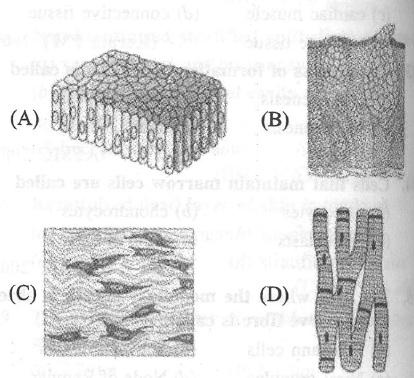 Tissue Location Function
Tissue Location Function
 Tissue Location Function
Tissue Location Function
Solution
Cardiac muscles are smooth muscles. cardiac tissue is contractile tissue.
Q65. State the significance of the typhlosole in earthworm.
Solution
The typhlosole increases the area of absorption in the intestine of earthworm.
Q66. Describe the exoskeleton of cockroach.
Solution
In cockroach, the exoskeleton is hard, chitinous and brown in colour.
It is made of hardened plates called sclerites.
The sclerites present on the dorsal side are called tergites, and the ones present on the ventral side are sternites.
Tergites and sternites are joined to one another by a flexible, articular membrane called the arthrodial membrane.
Q67. Draw a labelled diagram of squamous epithelial tissue.
Solution
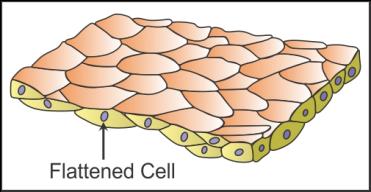
Q68. What is another term used for the gizzard of cockroach?
Solution
Proventriculus
Q69. Describe the respiratory system of cockroach.
Solution
The respiratory system of cockroach consists of a network
of tracheae.
Tracheae open outside through 10 pairs of spiracles
which are present on the lateral side of the body.
Tracheae are further divided into tracheoles which
carry oxygen to all parts of the body. Exchange of gases occurs at the
tracheoles by diffusion.
The openings of spiracles are regulated by the
sphincters.
Q70. Represent the digestive system of cockroach diagrammatically.
Solution
Digestive System of Cockroach:
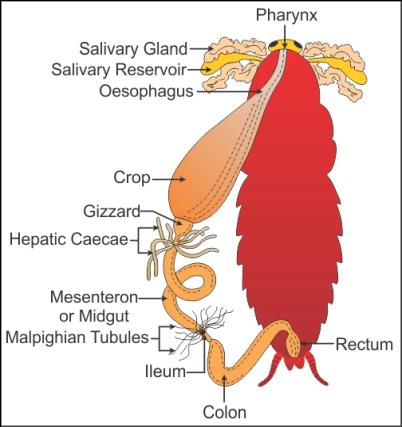

Q71. Haversian
canal occurs in
Solution
The Haversian
system is found in the long bones of mammals and absent in the spongy bones
of mammals.
Q72. Represent the mouth part of cockroach diagrammatically.
Solution
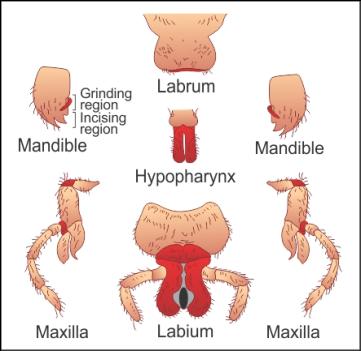
Q73. Draw a diagram of the female reproductive system and label any six
parts.
Solution
Female Reproductive System:


Q74. Write the names of three junctions found in the epithelium.
Solution
Three junctions found in the epithelium are
1. Tight junctions
2. Adhering junctions
3. Gap junctions
Q75. Name the connective tissue in which collagen is absent.
Solution
Blood
Q76. Which one of the following is not syncytial?
Solution
Smooth muscles are not striated. Each muscle fibre is with one nucleus. Many such fibres together are enclosed in a connective tissue sheath, but their cytoplasms are not fused.
Q77. Differentiate between unicellular and multicellular glandular epithelium.
Solution
Unicellular Glandular Epithelium
Multicellular Glandular Epithelium
1. Made of isolated glandular cells.
1. Consists of a cluster of cells.
2. Example: Goblet cells of the alimentary canal
2. Example: Salivary glands
Q78. Identify the connective tissue:
(a) Provides a structural framework to the body
(b) Transports various substances in the human body
(c) Supports the framework for epithelium
(d) Attaches skeletal muscles to bones
Solution
(a) Provides structural framework to the body - Bones
(b) Transports various substances in the human body - Blood
(c) Supports the framework for epithelium - Areolar tissue
(d) Attaches skeletal muscles to bones - Tendons
Q79. What is present at the junction of the foregut and midgut? State its
function.
Solution
Gastric or hepatic caecae are present at the junction of the foregut
and midgut. They secrete digestive juices.
Q80. Which set clearly indicates striated muscles?
Solution
Striated muscles are cylindrical with fibres enclosed in a connective sheath (skeletal muscles) or fused plasma membranes (cardiac muscles). They are multinucleated, and the cells do not exist independently, but their cytoplasms are fused.
Q81. What is a phallomere?
Solution
Phallomere is a chitinous asymmetrical structure which acts as the
external male genitalia which surrounds the male gonopore.
Q82. Which one of the following is the true description about an animal
concerned?
Solution
In cockroach, two pairs of spiracles are present in the thoracic
region and eight pairs are present in the abdominal region. Spiracles are slit-like
apertures through which air enters the body of a cockroach.
In rat, the right kidney is slightly higher in position than the left
kidney due to the position of the liver.
In earthworm, the correct sequence of the alimentary canal is pharynx,
oesophagus, gizzard, stomach and intestine.
In frog, the body is divisible into the head and trunk. The neck is
absent.
Q83. What are spermatophores?
Solution
Spermatophores are bundles of sperms glued together.
Q84. Give an account of three different types of simple epithelia.
Solution
Three major types of simple epithelia are
1) Squamous epithelium: Cells are flattened with irregular bodies.
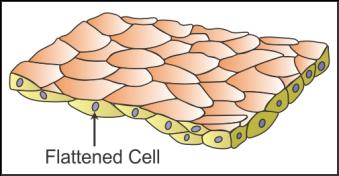 It is found in the walls of blood vessels and the air sacs of the lungs.
Its function is forming diffusion boundaries.
2) Cuboidal epithelium: Cells are cube-like and arranged in a single line.
It is found in the walls of blood vessels and the air sacs of the lungs.
Its function is forming diffusion boundaries.
2) Cuboidal epithelium: Cells are cube-like and arranged in a single line.
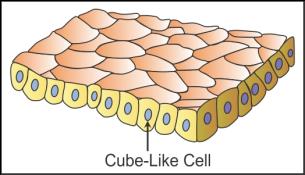 The cuboidal epithelium is commonly found in the ducts of glands, and the tubular parts of the kidneys are nephrons.
3) Columnar epithelium: Cells are tall and slender and arranged in a single line.
The nuclei of these cells are located at the base.
The cuboidal epithelium is commonly found in the ducts of glands, and the tubular parts of the kidneys are nephrons.
3) Columnar epithelium: Cells are tall and slender and arranged in a single line.
The nuclei of these cells are located at the base.
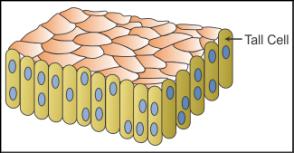 Columnar epithelium is found in the lining of the stomach and intestine. It aids in secretion and absorption.
In some cases, the free ends of cells possess microvilli. Such epithelium is called ciliated epithelium. The epithelium is responsible for the movement of mucus and particles in a specific direction.
Columnar epithelium is found in the lining of the stomach and intestine. It aids in secretion and absorption.
In some cases, the free ends of cells possess microvilli. Such epithelium is called ciliated epithelium. The epithelium is responsible for the movement of mucus and particles in a specific direction.
 It is found in the walls of blood vessels and the air sacs of the lungs.
Its function is forming diffusion boundaries.
2) Cuboidal epithelium: Cells are cube-like and arranged in a single line.
It is found in the walls of blood vessels and the air sacs of the lungs.
Its function is forming diffusion boundaries.
2) Cuboidal epithelium: Cells are cube-like and arranged in a single line.
 The cuboidal epithelium is commonly found in the ducts of glands, and the tubular parts of the kidneys are nephrons.
3) Columnar epithelium: Cells are tall and slender and arranged in a single line.
The nuclei of these cells are located at the base.
The cuboidal epithelium is commonly found in the ducts of glands, and the tubular parts of the kidneys are nephrons.
3) Columnar epithelium: Cells are tall and slender and arranged in a single line.
The nuclei of these cells are located at the base.
 Columnar epithelium is found in the lining of the stomach and intestine. It aids in secretion and absorption.
In some cases, the free ends of cells possess microvilli. Such epithelium is called ciliated epithelium. The epithelium is responsible for the movement of mucus and particles in a specific direction.
Columnar epithelium is found in the lining of the stomach and intestine. It aids in secretion and absorption.
In some cases, the free ends of cells possess microvilli. Such epithelium is called ciliated epithelium. The epithelium is responsible for the movement of mucus and particles in a specific direction.
Q85. Answer in one word:
Membrane which joins sclerites
A median flexible lobe enclosed by the mouth
parts
Cavity in which visceral organs are present
Hexagonal units present in compound eyes
Solution
Membrane which joins sclerites - Arthrodial
membrane
A median flexible lobe enclosed by the mouth
parts - Hypopharynx
Cavity in which visceral organs are present -
Haemocoel
Hexagonal units present in compound eyes -
Ommatidia
Q86. Name the fibrils present in the muscle tissue.
Solution
Myofibrils
Q87. Four healthy people in their twenties got involved in injuries
resulting in damage and death of a few cells of the following.
Which of the cells are least likely to be replaced by new cells?
Solution
Neurons are the only cells in the body which do not divide and cannot
be replaced.
Q88. Identify the type of epithelium:
(a) Single layer of tall and slender cells
(b) Unicellular columnar cells specialised in secretion
Solution
(a) Single layer of tall and slender cells - Columnar epithelium
(b) Unicellular columnar cells specialised in secretion - Unicellular
glandular epithelium
Q89. Name the type of muscle tissue in which the fibres taper at both ends
and do not show any striations.
Solution
Smooth muscles
Q90. What are the three types of simple epithelium on the basis of
structural modification?
Solution
The three types of simple epithelium on the basis of the structural
modification are
1. Squamous epithelium
2. Cuboidal epithelium
3. Columnar epithelium
Q91. What are spiracles?
Solution
Spiracles are the small openings on the lateral sides of the body of cockroach
though which the tracheae open outside.
Q92. Write the name of the frog species which is common in India.
Solution
Rana tigrina is commonly found in India.
Q93. How many times a nymph moults in order to attain the adult stage of
cockroach?
Solution
A nymph moults about 13 times to attain the adult stage of cockroach.
Q94. Write the function of Malpighian tubules in cockroach.
Solution
In cockroach, the Malpighian tubules absorb nitrogenous waste products
from the haemolymph and convert them into uric acid for excretion.
Q95. Stratum
germinativum is an example of which kind of epithelium?
Solution
Stratum
germinativum consists of columnar cells resting on a common basement
membrane.
Q96. State the name of the space into which the blood vessels open in
cockroaches.
Solution
Haemocoel
Q97. Name the structure which represents or acts as the brain in cockroach.
Solution
Supraoesophageal ganglion acts as the brain in cockroach.
Q98. Name the phylum and class to which frog belongs.
Solution
Frog belongs to the phylum Chordata and class Amphibia.
Q99. State the scientific term used for the tongue of cockroach.
Solution
Hypopharynx
Q100. Write any four sensory organs present in cockroach.
Solution
Sensory organs found in cockroach are
1. Antennae
2. Maxillary palps
3. Compound eyes
4. Labial palps
5. Anal cerci
(Write any four)
Q101. What is the scientific term used for the cells of cartilage?
Solution
The scientific term used for the cells of cartilage is chondrocytes.
Q102. Name the acid which is found in humans and is neutralised by the
calciferous glands of earthworms.
Solution
Humic acid
Q103. Name the regions in which the body of an earthworm is divided.
Solution
The body of an earthworm is divided into preclitellar, clitellar and
post-clitellar regions.
Q104. State the name of the plates which form the exoskeleton in cockroach.
Solution
Sclerites are the hard chitinous plates which form the exoskeleton in
cockroach.
Q105. Distinguish between simple epithelium and compound epithelium.
Solution
Simple Epithelium
Compound Epithelium
1. It
is composed of a single layer of cells.
1. It
is composed of more than one layer of cells.
2. It
is involved in functions such as diffusion, secretion, absorption etc.
2. It
is involved in the protection of the skin and inner linings of the organs.
Q106. Cockroaches are not of economic importance. Justify.
Or
Cockroaches are serious pests and vectors of several diseases.
Justify.
Solution
Human homes are the habitats of cockroaches. Cockroaches thrive in and
around human homes. They are pests because they contaminate food by their
excreta and destroy it. Through contamination of food, cockroaches also transmit
various bacterial diseases.
Q107. Distinguish between smooth muscles and cardiac muscles.
Solution
Smooth Muscles
Cardiac Muscles
1.
Striations are absent.
1.
Striations are present.
2. Cell
junctions hold the muscle fibres together and they are bundled together in
a sheath of connective tissue.
2.
Cell junctions fuse the plasma membrane of muscle fibres and make them
stick together.
3.
They are found in the walls of internal organs such as blood vessels,
stomach and intestines.
3.
Cardiac muscles are present in the heart.
Q108. State one difference between the nymph and adult cockroach.
Solution
The nymph bears wing pads in all stages, while the adult cockroach has
wings.
Q109. State the name of connective tissues.
Solution
The various connective tissues are cartilage, bone, blood and adipose
tissue.
Q110. Name the tissue which lines the inner surface of fallopian tubes.
Solution
Ciliated epithelium lines the inner surface of fallopian tubes.
Q111. Draw well-labelled diagrams of the following:
(a) Multicellular glandular epithelium
(b) Dense regular connective tissue
Solution
(a) Multicellular glandular epithelium:
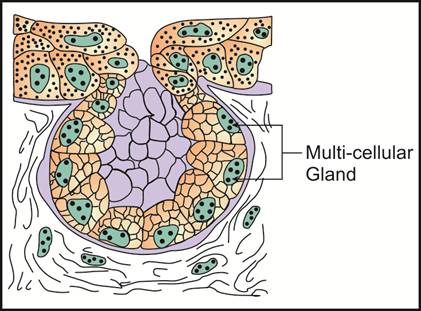 (b) Dense regular connective tissue:
(b) Dense regular connective tissue:

 (b) Dense regular connective tissue:
(b) Dense regular connective tissue:

Q112. State any two examples of dense connective tissue.
Solution
Tendons and ligaments are examples of dense connective tissue.
Q113. Represent the male reproductive system of cockroach diagrammatically.
Solution
Male Reproductive System of Cockroach:
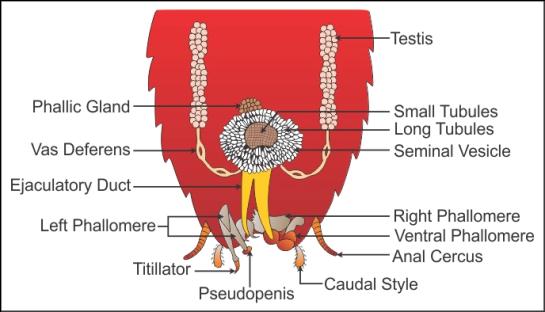

Q114. Draw a diagram of compound epithelium and state any one of its functions.
Solution
The compound epithelium provides protection to
organs against chemical and mechanical stresses.


Q115. Represent diagrammatically:
(a) Cardiac muscles
(b) Areolar tissue
Solution
(a) Cardiac muscles:
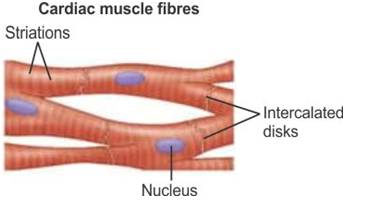 (b) Areolar tissue
(b) Areolar tissue
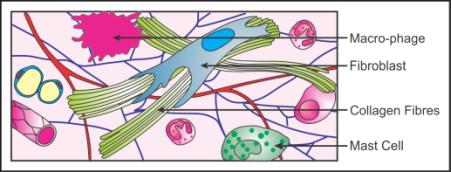
 (b) Areolar tissue
(b) Areolar tissue

Q116. Draw a well-labelled diagram of the reproductive system of earthworm.
Solution
Reproductive system of earthworm:
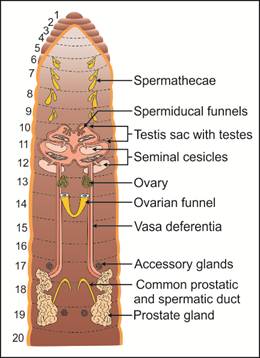

Q117. Define tissue.
Solution
The tissue is a group of similar cells along with intercellular spaces
which perform the same function.
Q118. Distinguish between cartilage and bones.
Solution
Cartilage
Bones
1. It
is solid and pliable.
1. They
are hard and non-pliable.
2. The
cells are called chondrocytes.
2.
The cells are called osteocytes.
3.
Cartilage resists compression.
3. They
provide a frame work to the body.
Q119. Name the membrane which protects the eyes while the frog is in water.
Solution
The nictitating membrane protects the eyes while the frog is in water.
Q120. How are earthworms traced in gardens?
Solution
Earthworms are traced by their faecal matter called worm casting in
gardens.
Q121. What is the meaning of paurometabolous development?
Solution
The development through the nymphal stages is called paurometabolous development.
Q122. What is clitellum?
Solution
Clitellum is a prominent dark band of glandular tissue which covers 14-16
segments in a mature earthworm.
Q123. State the names of two common Indian earthworms.
Solution
Pheretima and Lumbricus
Q124. If the head of a cockroach is cut off, it remains alive for one week.
Justify.
Solution
In cockroaches, a small part of the nervous system is present in the head
region. The rest of the nervous system is situated on the ventral side of the
body. Hence, if the head of a cockroach is cut off, it remains alive for one
week.
Q125. Name the structures other than the Malpighian tubules which help in
excretion in cockroach.
Solution
Besides the Malpighian tubules, nephrocytes, the fat body and urecose
glands help in excretion in cockroaches.
Q126. Where is the squamous epithelium found?
Solution
The squamous epithelium is found in the walls of blood vessels and air
sacs of the lungs.
Q127. Write the name of the sclerites which cover the body of cockroach ventrally.
Solution
Tergites
Q128. Describe the adipose tissue and its functions.
Solution
Adipose tissue is an example of loose connective tissue.
It is located beneath the skin.
Its cells are specialised to store fat. The excess of nutrients which
are not required by the body immediately are converted into fats and stored
in adipose tissue.
Q129. Distinguish between the abdomens of the male and female cockroach.
Solution
Abdomen of Male Cockroach
Abdomen of Female Cockroach
The
genital pouch lies at the hind end of the abdomen. It is bounded
dorsally by 9th and 10th terga and ventrally by
the 9th sternum.
The
genital pouch is formed when the 7th sternum fuses with the
8th and 9th sterna.
A
pair of short, thread-like anal styles is present.
Anal
styles are absent.
It
contains dorsal anus, male genital pore and gonapophysis.
It
contains female gonopore, spermathecal pores and collateral glands.
Q130. In a cockroach, the abdomen consists of how many segments?
Solution
The abdomen of cockroach consists of ten segments.
Q131. Write the name of organs where the smooth muscles are formed.
Solution
Smooth muscles are formed in blood vessels, intestines and stomach.
Q132. Write the names of the mouthparts found in cockroach.
Solution
The mouthparts found in cockroach are a labrum, a pair of mandibles, a
pair of maxillae and a labium.
Q133. Write the functions of the compound epithelium.
Solution
Functions of compound epithelium:
It provides protection against chemical and mechanical stresses.
It covers the dry surface of the skin as well as the moist surface of the buccal cavity, pharynx, inner lining of ducts of salivary glands and pancreatic ducts.
Q134. What is the function of antennae in cockroaches?
Solution
Antennae in cockroaches have sensory receptors which help in
monitoring the environment.
Q135. How does the gizzard help in grinding the food in cockroach?
Solution
The gizzard has an outer layer of thick circular muscles and a thick inner cuticle which together form six chitinous plates called teeth. These teeth help in grinding food.
Q136. State the function of the muscular gizzard in earthworm.
Solution
The muscular gizzard in earthworm helps in grinding the soil particles and decaying leaves.
Q137. What is the function of the neuroglial cell?
Solution
The function of the neuroglial cell is to protect and support neurons.
Q138. Define oothecae.
Solution
Oothecae
are dark reddish to brown colour capsules which enclose or encase the fertilised
eggs in cockroaches.
Q139. What is the length of an adult Periplaneta
americana?
Solution
The length of an adult Periplaneta
americana is 34-53 mm.
Comments
Post a Comment